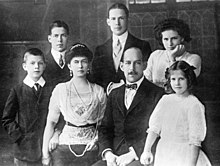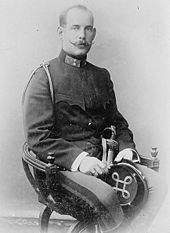Constantine I (Greece)
Constantine - Greek Κωνσταντίνος Α Βασιλεύς των Ελλήνων Konstantínos I Vasilefs ton Ellinon - (* July 21 . Jul / 2. August 1868 . Greg in Athens ; † 11. January 1923 in Palermo ) was a member of the Danish -griechischen Royals Schleswig-Holstein-Sonderburg-Glücksburg and from 1913 to 1917 and from 1920 to 1922 King of the Hellenes .
Origin and early years
Constantine was the eldest son of the Greek King George I and his wife Grand Duchess Olga Konstantinovna Romanova and was born on August 2, 1868 in Athens. The birth was greeted with a wave of enthusiasm by the Greek public, as the prince was the first native-born descendant of a modern monarch. In order to strengthen the identification between the royal family and the people, Constantine and his siblings were baptized Greek Orthodox and learned Greek from birth .
Initially, selected university professors took over the school instruction of Constantine, with Konstantinos Paparrigopoulos in particular imparting the principles of the Megali Idea to him. On October 30, 1882, he entered the Hellenic Military Academy Scholi Evelpidon in Piraeus . With his declaration of majority in 1884, Constantine was officially appointed heir to the throne (Greek διάδοχος "Diadochos") and received the title "Duke of Sparta" ( Δοὺξ τῆς Σπάρτης ); However, since the constitution did not provide for the granting of titles of nobility , the title was not applied to any of his successors. He completed his military and university training in the German Empire as a member of the Guard Regiment du Corps in Berlin and at the universities of Heidelberg and Leipzig , where he devoted himself to studying political science . In Heidelberg he was a member of the Corps Saxo-Borussia Heidelberg student union .
In 1890 he returned to Greece and embarked on a military career. With the rank of major general , Constantine assumed supreme command of the 3rd Army in Athens.
family
On October 27, 1889, Constantine married Princess Sophie of Prussia , daughter of Emperor Friedrich III, in the Athens Cathedral of the Annunciation . and his wife Victoria of Great Britain and Ireland . Sophie was the granddaughter of the British Queen Victoria and sister of the German Emperor Wilhelm II.
Six children emerged from the connection:
- Georg (1890–1947), as Georg II. Greek King ∞ Elisabeth of Romania
- Alexander (1893–1920), when Alexander I was King of Greece ∞ Aspasia Manos
- Elena (1896–1982) ∞ King Carol II of Romania
- Paul (1901–1964), as Paul I, Greek King ∞ Friederike von Hannover
- Irene (1904–1974) ∞ Aimone of Savoy-Aosta
- Katharina (1913–2007) ∞ Richard Brandram
Heir to the throne
Greece was a young kingdom that pursued a policy of expansion of the national territory with the aim of combining all Greek-populated areas into one state ( Megali Idea ). Since the Ottoman Empire controlled large parts of these claimed territories, the Turkish-Greek War broke out in 1897 . Constantine commanded the Thessaly Army, which, however, poorly equipped and trained, was decisively defeated by the Ottoman troops . The national bankruptcy of 1893 and the military defeat led to the royal princes' poor reputation among the population. This went so far that in 1909 insurgent officers demanded military reforms and the dismissal of the princes from the army ( Goudi revolt ). As a result, Constantine had to leave the country for a short time, but was given the post of General Inspector of the Army in 1911. This measure was related to the efforts of the liberal Prime Minister Eleftherios Venizelos to reach an understanding with the royal family.
After the First Balkan War broke out in October 1912, Constantine was once again given command of the Greek Army of Thessaly. With combined forces, the Serbian , Montenegrin , Bulgarian and Greek troops succeeded in almost completely ousting the Ottomans from the Balkan Peninsula . Constantine achieved significant military successes with the capture of the cities of Thessaloniki (October 27, 1912) and Ioannina (March 1913).
König (1913-17 and 1920-22)

After his father fell victim to an anarchist assassin in Thessaloniki on March 18, 1913 , Constantine succeeded him as the new king of the Hellenes . Peace in south-eastern Europe remained fragile when the next conflict broke out with the Second Balkan War at the end of June 1913. Constantine personally assumed supreme command of his armed forces and led them on the campaign against Bulgaria. At the end of the war there was the Bucharest Peace Treaty , which did not bring Greece to a full, but rather extensive, pacification of national claims. In the course of the Balkan Wars, the Greek territory increased by about 90 percent, Greece's population grew from 2.6 to 4.7 million inhabitants.
As the new monarch and victorious general, Constantine now enjoyed enormous popularity among the population that could only be compared with that of Venizelos. The king and head of government initially worked closely together, but their fundamentally different views on foreign policy issues divided the country in the so-called “national schism” , which was to shape Greek political life for decades. As a descendant of an originally German dynasty and brother-in-law of the German Emperor, Constantine was decidedly pro-German in his foreign policy stance, which is why he did not want his country to go into the First World War against the Central Powers . In contrast, Prime Minister Venizelos, who oriented himself towards the sea power Great Britain . Therefore, Constantine initially chose the path of neutrality , while Venizelos demanded entry into the war on the side of the Entente and was dismissed from office twice by the king in 1915. After a revolt in Thessaloniki, he returned to the political stage and formed a provisional revolutionary counter-government in northern Greece, which was recognized by the Entente and declared war on the Central Powers. This was the beginning of the "national schism". While Venizelos controlled northern Greece, Crete and the East Aegean islands , the rest of the country stood behind the royal government of Constantine. However, under increasing pressure from the Entente Powers and the dual leadership of the Venizelos government, Constantine was forced on 11 June 1917 to abdicate and the Crown Prince Georg over Corfu and with a feverish inflammation of an old surgical wound into Swiss exile to go where he in October of Ferdinand Sauerbruch the assistance of Anton Eiselsberg that since May 1915 the surgical treatment of a Rippenfellvereiterung was involved in Constantine, was operated on and leave the hospital in the early summer of 1918 was (according Sauerbruch the king went out of his re-ascent of the Greek throne made after which he then paid his treatment costs and awarded Sauerbruch the "Greek Order of Redeemer"). The new king was his second-born son Alexander .
After the sudden death of Alexander on October 25, 1920 and a surprising defeat by Venizelos in November, the royalist parties demanded Constantine's return from exile. After a plebiscite in which the majority of voters spoke out in favor of his return, Constantine returned to Greece and became king for the second time on December 19, 1920. The country continued to be at war even after the First World War and fought against Turkey in Asia Minor ( Greco-Turkish War ). Constantine immediately took command of the armed forces and went to the front in Asia Minor. In August 1921 Constantine ordered his troops to launch a major offensive on Ankara , but they suffered a major defeat in the Battle of Sakarya . The Turks counterattacked and gradually pushed the Greek army back to the coast. The political and financial situation in Greece deteriorated and in August 1922 the army had to withdraw from Asia Minor for good. The defeated army, led by officers close to Venizelos, demanded the resignation of the government and the king. On September 27, 1922, Constantine abdicated again and left the throne to his son Georg .
Constantine died in Palermo on January 11, 1923 at the age of 54 and was buried in the royal cemetery in Tatoi .
literature
- Gunnar Hering: Constantine I of Schleswig-Holstein-Sonderburg-Glücksburg . In: Biographical Lexicon on the History of Southeast Europe . Volume 2. Munich 1976, pp. 463-465
Web links
- Biography , Ellada (Greek)
- Constantine I , Hellenica
- Newspaper article about Constantine I in the 20th century press kit of the ZBW - Leibniz Information Center for Economics .
Individual evidence
- ^ Ferdinand Sauerbruch, Hans Rudolf Berndorff : That was my life. Kindler & Schiermeyer, Bad Wörishofen 1951; cited: Licensed edition for Bertelsmann Lesering, Gütersloh 1956, pp. 203-211.
- ^ Ferdinand Sauerbruch, Hans Rudolf Berndorff: That was my life. (1951) 1956, p. 234 f.
- ^ Ferdinand Sauerbruch, Hans Rudolf Berndorff: That was my life. (1951) 1956, p. 296.
| predecessor | Office | successor |
|---|---|---|
| George I. |
King of Greece 1913–1917 |
Alexander I. |
| Alexander I. |
King of Greece 1920–1922 |
George II |
| personal data | |
|---|---|
| SURNAME | Constantine I. |
| BRIEF DESCRIPTION | greek king |
| DATE OF BIRTH | August 2, 1868 |
| PLACE OF BIRTH | Athens |
| DATE OF DEATH | January 11, 1923 |
| Place of death | Palermo |




